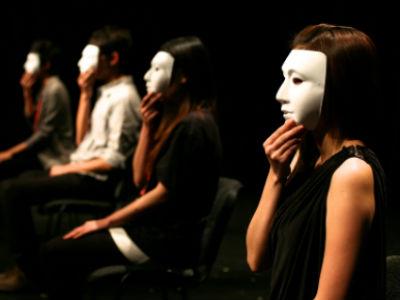Formal arts education is under attack from many directions. TAFE funding cuts are hitting the arts sector disproportionately and prominent playwright David Williamson has come out fighting for formal arts education.The debate about NIDA sparked by Chris Puplick in his Platform Paper this month raises some interesting issues about the nature of training programs in the creative arts. At present the question is focusing on actors, and might be paraphrased as: ‘To NIDA or not to NIDA?’ However there is a further – and perhaps more interesting – investigation to be made which looks more deeply at where actors, directors, playwrights and other theatre artists are coming from.
Through my current research into the training of theatre directors it turns out that some of our most significant artists haven’t come out of the major drama schools, but have cobbled together their own DIY training programs out of a combination of extra-curricular student theatre, independent theatre projects and informal mentorships. Leading names such as Barrie Kosky, Neil Armfield and Rosemary Myers are nominally ‘untrained’. Kosky was ‘discovered’ directing idiosyncratic shows at the University of Melbourne in the late 80s where he was studying music, Armfield had a similar trajectory from Sydney University a decade earlier, and Myers came out of James McCaughey’s Mill Theatre company in Geelong.
While these directors came to prominence when institutional director training courses were few, far between and low profile, it is significant that amongst the younger generation who have arrived at a time when such courses have proliferated and gained much greater prominence, some such as Simon Stone still ‘do it themselves’.
Far from supporting the notion that great artists are ‘born not made’, this fact is important because it highlights the different ways that individuals find their skills, understanding and a creative vision. NIDA, WAAPA and the VCA are one way, and DIY – in all its forms – is another. In this current discussion of arts training and the arguments about which drama school is getting it wrong or right, we should not lose sight of some of the alternative models.
In my current role as Artistic Director at the University of Melbourne’s Union Theatre I am in the midst of a thriving extra-curricular student theatre scene. It’s a heady mix of classics, new plays, devised works, comedy and of course, the ubiquitous musical – some of the work is awful but some is galvanising. The distinguishing thing is that few of the students who get involved want to be ‘stars’. Most are there to have fun, quite a few to have sex with each other, but also – significantly – many are involved because they are engaged by the ideas and complexity of theatre itself. You will often get someone in a show who is studying science or commerce or IT and the perspective they bring to the work can create fascinating new insights.
What then happens is that a number of these students realize that this is in fact what they really want to be doing with their lives and they immerse themselves in the student theatre ‘scene’. It is not uncommon for students to act in six shows in a year, and recently a student designer managed nine productions in one year. Students can quite rapidly gain a lot of experience, but it is those who start making their own work who seem to really thrive. They have resources, production support, autonomy, like-minded peers and an inexhaustible fund of ideas. In particular this environment seems to produce playwrights and ‘theatre makers’. The last decade at Melbourne University has been particularly rich in the former, with Lally Katz, Angus Cerini, Declan Green and Chris Summers all emerging since 2000, while the current crop of highly focused and talented students seems to be producing collectives, devising teams and directors.
What these ‘self-directed’ students often lack is technique and skill, which is where the formal courses come in. There is no doubting the value of studio training – those 40 plus, plus, plus hours of complete focus on creativity and craft every week, imprint a kind of familiarity with skills, choices and judgment which make it possible for an artist to match their imagination with their technique.
Ideally theatre training should include both of these attributes – the inspiration and the perspiration, if you like. Whether such a combination can exist within any institution or whether it must be an ongoing journey that happens beyond the schools and universities is the question.
At the moment it is happening in independent theatre. Companies like the Hayloft Project, Black Lung, Real TV, The Rabble, My Darling Patricia and Suitcase Royale have all contributed distinctively but differently to the creation of a performance culture that feels confident and forward-looking. Some of these artists came from drama school, some emerged from student theatre and some just launched themselves straight into the fray – often companies include people from all these sources – but nearly always they got together when they were young and have, in effect, created their artistic identities on the job.
It would be wonderful if the debate about the training of performing artists in this country could broaden out from the focus on the elite drama schools and universities, and consider the informal and self-generated learning environments that also produce significant numbers of influential artists. In this way we might be able to generate policy debate and new approaches in the institutions, as well as recognizing the role that informal environments like extra-curricular student theatre play in Australia’s performing arts culture.





